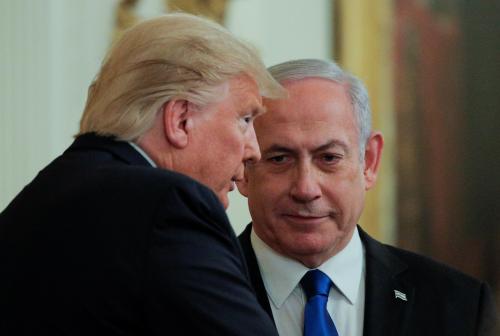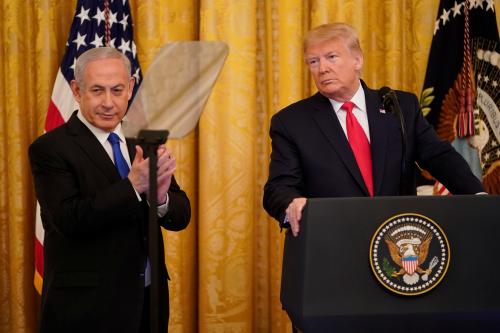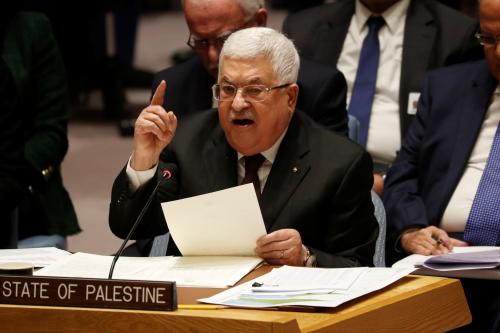A lot, if you are Palestinian. Even before reading past the plan’s first few pages, virtually no Palestinian could be reasonably expected to still be looking for a silver lining in its details. This should come as no surprise. The plan’s introduction cites Prime Minister Yitzhak Rabin’s October 1995 speech before the Knesset, in which he sought to win approval for the Oslo II Interim Agreement by laying out a vision of a future Palestinian entity that he described as “less than a state.” That citation had a profound impact on me.
For what else can be made of a plan that emphasizes that the Palestinian leadership did not reject Rabin’s vision at the time? And, as if the point the plan’s authors were trying to drive home was not adequately clear, they made sure to underscore that Rabin’s vision was explicit on “Jerusalem remaining united under Israeli rule; on the portions of the West bank with large Jewish populations and the Jordan valley being incorporated in Israel; and on the remainder of the West Bank, along with Gaza, becoming subject to Palestinian autonomy…in something that was less than a state.” With Trump’s vision embracing these tenets of Rabin’s, the authors are clearly suggesting that the widely anticipated Palestinian rejection of the plan is unjustifiable.
There is a lot to unpack here. To begin with, the assertion that the Palestinian leadership did not reject Rabin’s vision does not mean they accepted it. To be sure, what that leadership signed on to under the Oslo framework was a mere autonomy, and only in parts of the Palestinian territory that Israel occupied in 1967. But what they thought they were getting, after an interim period of five years, was a state that Palestinians could proudly call home. And they were not alone in thinking that way. Whether on grounds of fairness, legality, practicality, or a combination thereof, there indeed developed a broad international consensus, including in Israel itself, in favor of a two-state vision that both Israelis and Palestinians could live with. That, in a nutshell, was what the various American-led mediation attempts had sought, but failed, to accomplish since Oslo.
Without much analysis, the plan’s authors suggest that past mediation efforts were doomed by their lack of comprehensiveness, the absence of substantial economic content, and the failure to adequately take into account the prevailing realities. While the causes of that failure are varied, the first two explanations the authors offer are questionable.
For one thing, the assertion of lack of comprehensiveness ignores the record of extensive negotiations and detailed work throughout successive rounds of mediation and diplomacy over the past 25 years. For another, it is worth recalling that the tripartite framework (consisting of Israel, the Palestinian Authority, and the international donor community) was, since the inception of the Palestinian Authority, anchored on a heavy economic and Palestinian capacity-building component.
As to the authors’ third explanation, the framing of the Trump administration’s plan and the specific language it deploys would seem to suggest that what it really wanted to say was that past efforts did not go far enough in prioritizing the Israeli narrative — or, more specifically, that they failed to fully embrace the worldview of Israel’s far-right. This may sound like a strong statement. In reality, however, its validity is underscored by the plan’s abridgment of the Palestinians’ right to self-determination, if not by its dismissiveness of the Palestinian narrative altogether.
The framing of the Trump administration’s plan…would seem to suggest that what it really wanted to say was that past efforts did not go far enough in prioritizing the Israeli narrative.
Indeed, the plan specifically requires the realization of the Palestinians’ right to self-determination to be limited to a “path to a dignified national life,” with Israel being and remaining the only state with full sovereignty and control over the entire area west of the Jordan River. Of special significance in this regard is the earmarking for annexation by Israel — effectively at a time of its choosing, no less — of the Jordan Valley and other areas of the West Bank that are vitally important to the viability of any future Palestinian state. In addition, while the plan asserts respect for “the historic and religious significance of the region to its people,” its insistence on Jerusalem remaining united under Israel’s full sovereignty is another case in point.
Yet another problem is the not-so-subtle attempt to strip the Palestinian refugee issue of any political dimension. On top of its emphatic, explicit denial of the right of return for refugees, the plan equally categorically excludes Israel as a possible home destination. It also places limitations, and vests in Israel a veto power, on the extent to which the “state of Palestine” can serve as a home destination — not to mention that, in addition, it circumscribes the possibility of direct compensation.
Furthermore, the plan is replete with other examples and suggestions regarding whose narrative should prevail. These include the suggestion that Palestinians have no territorial rights whatsoever, as is clearly implied by the plan’s reference to “the designation” of territory “to which Israel has asserted valid legal and historical claims” for a future Palestinian state; the expectation of having individual title possession claims when drawing the borders, subject to litigation within the Israeli legal system; and the limitation on the Palestinian state’s purview over planning and zoning in areas adjacent to its border with Israel, without even suggesting any limitation on Israel’s latitude to veto Palestinian decisions in this regard.
There are other deeply troubling aspects of the plan for Palestinians in general, but especially for those who are citizens of the state of Israel, at least in two areas. The first relates to what appears to be a deliberate exclusion of political rights from the realm of protected rights of citizenship, while the second relates to the proposal to incorporate the “Triangle Communities” into the state of Palestine not being contingent on the consent of the residents of that region.
Unlike in 1995, the Palestinian leadership can have no illusion at this juncture that the offer at hand is about anything but a “state minus.”
If the serious structural shortcomings outlined above are not reason enough for Palestinians not to want to have anything to do with Trump’s vision, consider this. Unlike in 1995, the Palestinian leadership can have no illusion at this juncture that the offer at hand is about anything but a “state minus.” Worse, not even that is a sure thing. Rather, it is the opportunity to embark on a four-year qualification odyssey in a quest for that “state minus,” with Israel and the United States jointly keeping score on the Palestinian effort in the governance sphere in general, and with Israel alone being the ultimate judge of the Palestinians’ performance in the realm of security.
When the plan’s resuscitation of the “Quartet Principles” is considered — along with its simultaneous statement that Hamas must be disarmed in Gaza as a requirement within the framework of those principles —one can easily see that rather than a “path to a dignified national life,” (or, less charitably, “state minus”), the proposed prequalification exercise is a path to nowhere. Even Israeli Prime Minister Benjamin Netanyahu all but said as much on January 28, when, standing alongside the president of the United States, he brazenly declared: “I know it may take [the Palestinians] a very long time to reach the end of that path. It may take them a very long time to get to the beginning of that path.” This happens to be true, even if — fearing that his constituency back in Israel would not be adequately reassured by his relegation of the issue of Palestinian statehood to endless negotiations — the prime minister merely intended to help secure a right-wing majority in the upcoming Israeli elections.
All of this provides a compelling basis for a Palestinian rejection of Trump’s vision. It is well to keep in mind, however, that, by itself, such rejection does not render that vision inconsequential. Nor should it, therefore, be conflated with a rejection strategy, with the latter requiring a clear-eyed assessment of the existential risks the Palestinian national movement faces, an informed identification of available policy choices, and the willpower needed to pursue them.
Such would be an act of leadership whose absence at several inflection points over the past century better explains the causes of Palestinian failures than the mere rejection of past visons or plans. Needless to say, the Palestinian effort going forward should not at all be encumbered by the heavy weight of the false narrative underlying the adage “every time Palestinians say ‘no’, they lose.” To be sure, we did not fare too well either on the countless times we said “yes,” particularly since 1988.
One way in which Trump’s vision can be catastrophically consequential in the near term lies in the distinct possibility that Israel will act on that vision’s greenlighting of the annexation of territory that is vital to the viability of Palestinian statehood. While initially touted as imminent, there is ambiguity now as to when that step will actually be taken. Nevertheless, the plan itself did not at all link Israeli annexation to negotiations, or any other benchmark for that matter. Thus, it could potentially happen any time, more likely sooner than later. This points to the obvious need for Palestinians to prioritize stopping the Israeli annexation drive, as a matter of utmost urgency, as they formulate an effective rejection strategy.
Such a strategy need not, and should not, be framed in terms of Palestinian readiness to engage regionally or internationally on the basis of Trump’s vision. Rather, it could take the form of launching a Palestinian initiative that takes advantage of the plan’s repeated reference to “the issues having to ultimately be resolved in negotiations between the parties themselves” to require precluding the possibility of any Israeli annexation before completing negotiations. The initiative could go on to elaborate a Palestinian four-year program of action that is anchored on furthering the cause of Palestinian empowerment, beginning with the all-important reunification of the Palestinian polity and fortification of national governance institutions and processes. This would require the immediate convening of the Unified Leadership Framework — a forum with representatives from the full spectrum of the Palestinian body politic — with a view to agreeing on the basis for assuring non-Palestine Liberation Organization (PLO) factions of genuine partnership in decisionmaking, without requiring them to alter their individual party platforms.
It is, of course, understood that the plan’s insistence on a strict application of the “Quartet Principles” would complicate matters in this regard. That, however, should be a reason for Palestinian recalcitrance, not hesitation. Only an inclusive political framework that is not conditioned on the acceptance by non-PLO factions of the PLO’s political platform can, at this juncture, help bring about the desperately needed intra-Palestinian reconciliation.
It is far from certain that such an initiative could save the Palestinian cause. But, its capacity to alter the negative dynamic that has prevailed since the plan was launched should not be underestimated. If nothing else, it certainly beats the dry parroting of the — by now unmoving — two-state solution eulogies. Far better than that, it could spur Palestinians into the kind of action that should have been undertaken a long time ago. After all, the writing has been on the wall for quite some time. For the plan can objectively be seen as merely having been an attempt at formalizing, in the authors’ words, “today’s realities” — with the dominantly prevailing version of those realities being, and having been for a while, a Palestinian state lookalike in Gaza and another on the West Bank’s leftovers.
The Palestinian Authority has become an instrument of national entrapment and disempowerment for the Palestinian people.
In that sense, Trump’s vision may already have been consequential in one important, positive way — namely, it has brought into much greater focus than ever before an inconvenient truth that the Palestinian leadership must contend with as it wrestles with the question of where to go from here. That truth is that the Palestinian Authority has become an instrument of national entrapment and disempowerment for the Palestinian people. Among other things, by virtue of assuming responsibility — as a national authority — for the welfare of Palestinians under occupation, it provided Israel, long before the Trump administration’s plan, with an important counter-argument against charges of apartheid. The mere rejection of the plan is not going to alter this reality. For even if it does not turn into the “state minus” state envisaged under Trump’s vision — or, 25 years ago, under Rabin’s — the Authority will continue to serve that important Israeli political need while blocking, in the process, a channel of potential positive influence.
Therefore, in parallel with the effort to forge a strategy along the lines outlined above — indeed, as an integral part of that effort — Palestinians have to come to terms with whether they will be able to summon the willpower needed to turn their Authority from the instrument of entrapment and disempowerment it has become to the instrument of empowerment it needs to be. If not, then we are duty-bound to embark on the more challenging dual task of revamping our national program and remaking our institutions.
It would be a travesty if this were to be understood as an echo of the often-repeated call on the Palestinian Authority to disband by simply “throwing the keys to Netanyahu.” Even if it were followed, such course of action would not guarantee that its implied objective of turning the conflict into a struggle for equal rights in one state will be realized. Far from it, the most enduring legacy of the Oslo Accords has been a Palestinian Authority that, by splintering into two “state minus” states some 13 years ago, has already demonstrated the capacity to multiply. But more worrisome — absent an effective preventive strategy — should be what has become a built-in potential for it to be succeeded by a reincarnation of its old self.







Commentary
Trump’s Middle East peace plan: What’s there to be upset about?
February 21, 2020